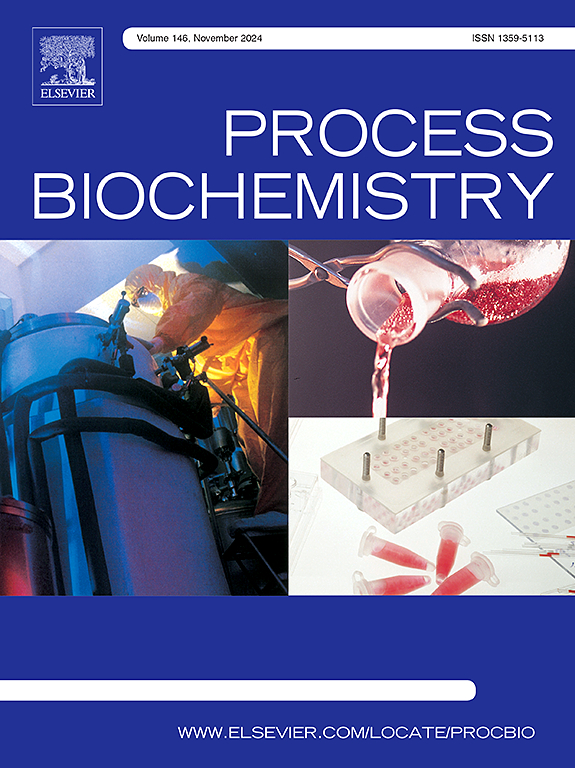Enhancing thermostability of lysine hydroxylase via a semi-rational design
IF 3.7
3区 生物学
Q2 BIOCHEMISTRY & MOLECULAR BIOLOGY
引用次数: 0
Abstract
(2S,4 R)-4-Hydroxylysine (4-OH-Lys), a derivative of L-lysine, possesses a unique chemical structure that makes it a crucial precursor for the synthesis of pharmaceutical molecules, with extensive applications in the pharmaceutical and biochemical industries. Lysine hydroxylase (K4H) catalyzes the conversion of L-lysine to 4-OH-Lys, offering advantages such as mild reaction conditions, straightforward reaction steps, good regioselectivity, and high catalytic efficiency compared to chemical synthesis and natural extraction methods. However, the low thermostability of K4H hinders its application in large-scale production. In this study, we employed a semi-rational design approach, guided by ΔΔG folding free energy calculations and message-passing neural networks to enhance the thermostability of K4H. After two rounds of evolution, we identified two beneficial mutants: M25 (S101P/Q257M) and M32 (Q257M/V298I). Thermostability assessments revealed that the half-lives (t1/2) of M25 and M32 at 40 °C were 23.9-fold and 13.3-fold higher than that of the wild-type (WT), with melting temperatures (Tm) exceeding those of WT by 4.2 °C and 8.3 °C, respectively. Molecular dynamics simulations illuminated the mechanisms underlying this enhanced thermostability. This work provides valuable insights into the thermostability of K4H and yields key mutants that are promising candidates for practical production of 4-OH-Lys.
半合理设计提高赖氨酸羟化酶的热稳定性
(2S,4 R)-4-羟基赖氨酸(4- oh -lys)是l -赖氨酸的衍生物,具有独特的化学结构,是合成药物分子的重要前体,在制药和生化工业中有着广泛的应用。赖氨酸羟化酶(Lysine hydroxylase, K4H)催化l -赖氨酸转化为4- oh -赖氨酸,与化学合成和天然提取方法相比,具有反应条件温和、反应步骤简单、区域选择性好、催化效率高等优点。然而,K4H的低热稳定性阻碍了其在大规模生产中的应用。在本研究中,我们采用半理性设计方法,以ΔΔG折叠自由能计算和信息传递神经网络为指导,增强K4H的热稳定性。经过两轮进化,我们确定了两个有益的突变体:M25 (S101P/Q257M)和M32 (Q257M/V298I)。热稳定性评价表明,M25和M32在40℃时的半衰期(t1/2)分别是野生型(WT)的23.9倍和13.3倍,熔融温度(Tm)分别比野生型(WT)高4.2℃和8.3℃。分子动力学模拟阐明了这种增强热稳定性的机制。这项工作为K4H的热稳定性提供了有价值的见解,并产生了有希望用于实际生产4-OH-Lys的关键突变体。
本文章由计算机程序翻译,如有差异,请以英文原文为准。
求助全文
约1分钟内获得全文
求助全文
来源期刊

Process Biochemistry
生物-工程:化工
CiteScore
8.30
自引率
4.50%
发文量
374
审稿时长
53 days
期刊介绍:
Process Biochemistry is an application-orientated research journal devoted to reporting advances with originality and novelty, in the science and technology of the processes involving bioactive molecules and living organisms. These processes concern the production of useful metabolites or materials, or the removal of toxic compounds using tools and methods of current biology and engineering. Its main areas of interest include novel bioprocesses and enabling technologies (such as nanobiotechnology, tissue engineering, directed evolution, metabolic engineering, systems biology, and synthetic biology) applicable in food (nutraceutical), healthcare (medical, pharmaceutical, cosmetic), energy (biofuels), environmental, and biorefinery industries and their underlying biological and engineering principles.
 求助内容:
求助内容: 应助结果提醒方式:
应助结果提醒方式:


